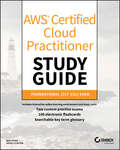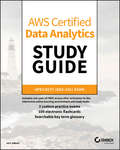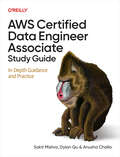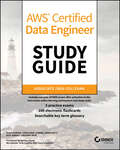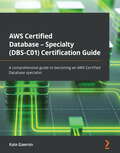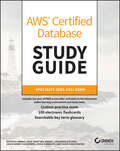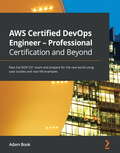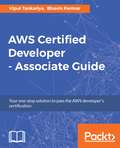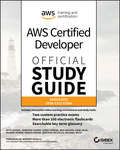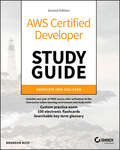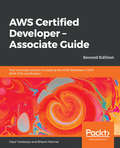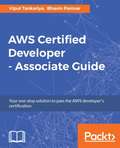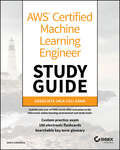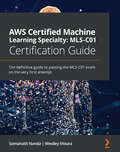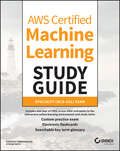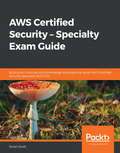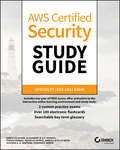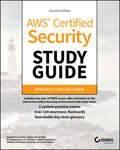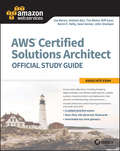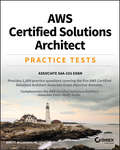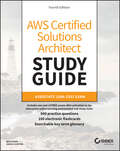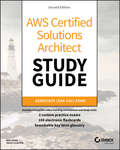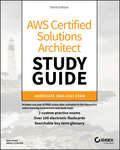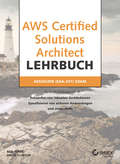- Table View
- List View
AWS Certified Cloud Practitioner Study Guide: CLF-C01 Exam
by David Clinton Ben PiperSet yourself apart by becoming an AWS Certified Cloud Practitioner Take the next step in your career by expanding and validating your skills on the Amazon Web Services (AWS) Cloud. The AWS Certified Cloud Practitioner Study Guide: Exam CLF-C01 provides a solid introduction to this industry-leading technology, relied upon by thousands of businesses across the globe, as well as the resources you need to prove your knowledge in the AWS Certification Exam. This guide offers complete and thorough treatment of all topics included in the exam, beginning with a discussion of what the AWS cloud is and its basic global infrastructure and architectural principles. Other chapters dive into the technical, exploring core characteristics of deploying and operating in the AWS Cloud Platform, as well as basic security and compliance aspects and the shared security model. In addition, the text identifies sources of documentation or technical assistance, such as white papers or support tickets. To complete their coverage, the authors discuss the AWS Cloud value proposition and define billing, account management, and pricing models. This includes describing the key services AWS can provide and their common use cases (e.g., compute, analytics, etc.). Distinguish yourself as an expert by obtaining a highly desirable certification in a widely used platform Hone your skills and gain new insights on AWS whether you work in a technical, managerial, sales, purchasing, or financial field Fully prepare for this new exam using expert content and real-world knowledge, key exam essentials, chapter review questions, and other textual resources Benefit from access to the Sybex online interactive learning environment and test bank, including chapter tests, practice exams, key term glossary, and electronic flashcards The AWS Certified Cloud Practitioner Study Guide is essential reading for any professional in IT or other fields that work directly with AWS, soon-to-be graduates studying in those areas, or anyone hoping to prove themselves as an AWS Certified Cloud Practitioner.
AWS Certified Data Analytics Study Guide: Specialty (DAS-C01) Exam
by Asif AbbasiMove your career forward with AWS certification! Prepare for the AWS Certified Data Analytics Specialty Exam with this thorough study guide This comprehensive study guide will help assess your technical skills and prepare for the updated AWS Certified Data Analytics exam. Earning this AWS certification will confirm your expertise in designing and implementing AWS services to derive value from data. The AWS Certified Data Analytics Study Guide: Specialty (DAS-C01) Exam is designed for business analysts and IT professionals who perform complex Big Data analyses. This AWS Specialty Exam guide gets you ready for certification testing with expert content, real-world knowledge, key exam concepts, and topic reviews. Gain confidence by studying the subject areas and working through the practice questions. Big data concepts covered in the guide include: Collection Storage Processing Analysis Visualization Data security AWS certifications allow professionals to demonstrate skills related to leading Amazon Web Services technology. The AWS Certified Data Analytics Specialty (DAS-C01) Exam specifically evaluates your ability to design and maintain Big Data, leverage tools to automate data analysis, and implement AWS Big Data services according to architectural best practices. An exam study guide can help you feel more prepared about taking an AWS certification test and advancing your professional career. In addition to the guide’s content, you’ll have access to an online learning environment and test bank that offers practice exams, a glossary, and electronic flashcards.
AWS Certified Data Engineer Associate Study Guide: In-Depth Guidance and Practice
by Sakti Mishra Anusha Challa Dylan QuThere's no better time to become a data engineer. And acing the AWS Certified Data Engineer Associate (DEA-C01) exam will help you tackle the demands of modern data engineering and secure your place in the technology-driven future. Authors Sakti Mishra, Dylan Qu, and Anusha Challa equip you with the knowledge and sought-after skills necessary to effectively manage data and excel in your career. Whether you're a data engineer, data analyst, or machine learning engineer, you'll discover in-depth guidance, practical exercises, sample questions, and expert advice you need to leverage AWS services effectively and achieve certification. By reading, you'll learn how to: Ingest, transform, and orchestrate data pipelines effectively Select the ideal data store, design efficient data models, and manage data lifecycles Analyze data rigorously and maintain high data quality standards Implement robust authentication, authorization, and data governance protocols Prepare thoroughly for the DEA-C01 exam with targeted strategies and practices
AWS Certified Data Engineer Study Guide: Associate (DEA-C01) Exam (Sybex Study Guide)
by Lakshmi Nair Asif Abbasi Syed Humair Chenjerai Gumbo Adam GattYour complete Guide to preparing for the AWS® Certified Data Engineer: Associate exam The AWS® Certified Data Engineer Study Guide is your one-stop resource for complete coverage of the challenging DEA-C01 Associate exam. This Sybex Study Guide covers 100% of the DEA-C01 objectives. Prepare for the exam faster and smarter with Sybex thanks to accurate content including, an assessment test that validates and measures exam readiness, real-world examples and scenarios, practical exercises, and challenging chapter review questions. Reinforce and retain what you’ve learned with the Sybex online learning environment and test bank, accessible across multiple devices. Get ready for the AWS Certified Data Engineer exam – quickly and efficiently – with Sybex. Coverage of 100% of all exam objectives in this Study Guide means you’ll be ready for: Data Ingestion and TransformationData Store ManagementData Operations and SupportData Security and Governance ABOUT THE AWS DATA ENGINEER – ASSOCIATE CERTIFICATION The AWS Data Engineer – Associate certification validates skills and knowledge in core data-related Amazon Web Services. It recognizes your ability to implement data pipelines and to monitor, troubleshoot, and optimize cost and performance issues in accordance with best practices Interactive learning environment Take your exam prep to the next level with Sybex’s superior interactive online study tools. To access our learning environment, simply visit www.wiley.com/go/sybextestprep, register your book to receive your unique PIN, and instantly gain one year of FREE access after activation to: • Interactive test bank with 5 practice exams to help you identify areas where further review is needed. Get more than 90% of the answers correct, and you’re ready to take the certification exam. • 100 electronic flashcards to reinforce learning and last-minute prep before the exam • Comprehensive glossary in PDF format gives you instant access to the key terms so you are fully prepared
AWS Certified Database - Specialty (DBS-C01) Certification Guide: A comprehensive guide to becoming an AWS Certified Database specialist
by Kate GawronPass the AWS Certified Database- Specialty Certification exam with the help of practice tests Key FeaturesUnderstand different AWS database technologies and when to use themMaster the management and administration of AWS databases using both the console and command lineComplete, up-to-date coverage of DBS-C01 exam objectives to pass it on the first attemptBook DescriptionThe AWS Certified Database – Specialty certification is one of the most challenging AWS certifications. It validates your comprehensive understanding of databases, including the concepts of design, migration, deployment, access, maintenance, automation, monitoring, security, and troubleshooting. With this guide, you'll understand how to use various AWS databases, such as Aurora Serverless and Global Database, and even services such as Redshift and Neptune. You'll start with an introduction to the AWS databases, and then delve into workload-specific database design. As you advance through the chapters, you'll learn about migrating and deploying the databases, along with database security techniques such as encryption, auditing, and access controls. This AWS book will also cover monitoring, troubleshooting, and disaster recovery techniques, before testing all the knowledge you've gained throughout the book with the help of mock tests. By the end of this book, you'll have covered everything you need to pass the DBS-C01 AWS certification exam and have a handy, on-the-job desk reference guide.What you will learnBecome familiar with the AWS Certified Database – Specialty exam formatExplore AWS database services and key terminologyWork with the AWS console and command line used for managing the databasesTest and refine performance metrics to make key decisions and reduce costUnderstand how to handle security risks and make decisions about database infrastructure and deploymentEnhance your understanding of the topics you've learned using real-world hands-on examplesIdentify and resolve common RDS, Aurora, and DynamoDB issuesWho this book is forThis AWS certification book is for database administrators and IT professionals who perform complex big data analysis as well as students looking to get AWS Database Specialty certified. A solid understanding of cloud computing, specifically AWS services, is a must. Knowledge of basic administration tasks such as logging in and running SQL queries will be helpful.
AWS Certified Database Study Guide: Specialty (DBS-C01) Exam
by Matheus Arrais Rene Martinez Bravet Leonardo Ciccone Angie Nobre Cocharero Erika Kurauchi Hugo RozestratenValidate your AWS Cloud database skills! AWS Certified Database Study Guide: Specialty (DBS-C01) Exam focuses on helping you to understand the basic job role of a database administrator / architect and to prepare for taking the certification exam. This is your opportunity to take the next step in your career by expanding and validating your skills on the AWS Cloud, and performing a database-focused role. AWS is the frontrunner in cloud computing products and services, and this study guide will help you to gain an understanding of core AWS services, uses, and basic AWS database design and deployment best practices. AWS offers more than relational and nonrelation databases, they offer purpose built databases, which allow you to utilize database services prebuilt to meet your business requirements. If you are looking to take the Specialty (DBS-C01) exam, this Study Guide is what you need for comprehensive content and robust study tools that will help you gain the edge on exam day and throughout your career. AWS Certified Database certification offers a great way for IT professionals to achieve industry recognition as cloud experts. This new study guide is perfect for you if you perform a database-focused role and want to pass the DBS-C01 exam to prove your knowledge of how to design and deploy secure and robust database applications on AWS technologies. IT cloud professionals who hold AWS certifications are in great demand, and this certification could take your career to the next level! Master all the key concepts you need to pass the AWS Certified Database Specialty (DBS-C01) Exam Further your career by demonstrating your cloud computing expertise and your knowledge of databases and database services Understand the concept of purpose built databases, allowing you to pick the right tool for the right job. Review deployment and migration, management and operations, monitoring and troubleshooting, database security, and more Access the Sybex online learning environment and test bank for interactive study aids and practice questionsReaders will also get one year of FREE access after activation to Sybex’s superior online interactive learning environment and test bank, including hundreds of questions, a practice exam, electronic flashcards, and a glossary of key terms.
AWS Certified DevOps Engineer - Professional Certification and Beyond: Pass the DOP-C01 exam and prepare for the real world using case studies and real-life examples
by Adam BookExplore the ins and outs of becoming an AWS certified DevOps professional engineer with the help of easy-to-follow practical examples and detailed explanationsKey FeaturesDiscover how to implement and manage continuous delivery systems and methodologies on AWSExplore real-world scenarios and hands-on examples that will prepare you to take the DOP-C01 exam with confidenceLearn from enterprise DevOps scenarios to prepare fully for the AWS certification examBook DescriptionThe AWS Certified DevOps Engineer certification is one of the highest AWS credentials, vastly recognized in cloud computing or software development industries. This book is an extensive guide to helping you strengthen your DevOps skills as you work with your AWS workloads on a day-to-day basis.You'll begin by learning how to create and deploy a workload using the AWS code suite of tools, and then move on to adding monitoring and fault tolerance to your workload. You'll explore enterprise scenarios that'll help you to understand various AWS tools and services. This book is packed with detailed explanations of essential concepts to help you get to grips with the domains needed to pass the DevOps professional exam. As you advance, you'll delve into AWS with the help of hands-on examples and practice questions to gain a holistic understanding of the services covered in the AWS DevOps professional exam. Throughout the book, you'll find real-world scenarios that you can easily incorporate in your daily activities when working with AWS, making you a valuable asset for any organization.By the end of this AWS certification book, you'll have gained the knowledge needed to pass the AWS Certified DevOps Engineer exam, and be able to implement different techniques for delivering each service in real-world scenarios.What you will learnAutomate your pipelines, build phases, and deployments with AWS-native toolingDiscover how to implement logging and monitoring using AWS-native toolingGain a solid understanding of the services included in the AWS DevOps Professional examReinforce security practices on the AWS platform from an exam point of viewFind out how to automatically enforce standards and policies in AWS environmentsExplore AWS best practices and anti-patternsEnhance your core AWS skills with the help of exercises and practice testsWho this book is forThis book is for AWS developers and SysOps administrators looking to advance their careers by achieving the highly sought-after DevOps Professional certification. Basic knowledge of AWS as well as its core services (EC2, S3, and RDS) is needed. Familiarity with DevOps concepts such as source control, monitoring, and logging, not necessarily in the AWS context, will be helpful.
AWS Certified Developer - Associate Guide
by Vipul Tankariya Bhavin ParmarAn effective guide to becoming an AWS Certified Developer About This Book • This fast-paced guide will help you clear the exam with confidence • Learn to design, develop, and deploy cloud-based solutions using AWS • Enhance your AWS skills with practice questions and mock tests Who This Book Is For This book is for IT professionals and developers looking to clear the AWS Certified Developer – Associate 2017 exam. Developers looking to develop and manage their applications on the AWS platform will also find this book useful. No prior AWS experience is needed. What You Will Learn • Create and manage users, groups, and permissions using AWS Identity and Access Management services • Create a secured Virtual Private Cloud (VPC) with Public and Private Subnets, Network Access Control, and Security groups • Get started with Elastic Compute Cloud (EC2), launching your first EC2 instance, and working with it • Handle application traffic with Elastic Load Balancing (ELB) and monitor AWS resources with CloudWatch • Work with AWS storage services such as Simple Storage Service (S3), Glacier, and CloudFront • Get acquainted with AWS DynamoDB – a NoSQL database service • Coordinate work across distributed application components using Simple Workflow Service (SWF) In Detail AWS Certified Developer - Associate Guide starts with a quick introduction to AWS and the prerequisites to get you started. Then, this book gives you a fair understanding of core AWS services and basic architecture. Next, this book will describe about getting familiar with Identity and Access Management (IAM) along with Virtual private cloud (VPC). Moving ahead you will learn about Elastic Compute cloud (EC2) and handling application traffic with Elastic Load Balancing (ELB). Going ahead you we will talk about Monitoring with CloudWatch, Simple storage service (S3) and Glacier and CloudFront along with other AWS storage options. Next we will take you through AWS DynamoDB – A NoSQL Database Service, Amazon Simple Queue Service (SQS) and CloudFormation Overview. Finally, this book covers understanding Elastic Beanstalk and overview of AWS lambda. At the end of this book, we will cover enough topics, tips and tricks along with mock tests for you to be able to pass the AWS Certified Developer - Associate exam and develop as well as manage your applications on the AWS platform. Style and approach This step-by-step guide includes exercises and mock tests to clear the AWS certification exam and become a successful AWS developer.
AWS Certified Developer Official Study Guide, Associate Exam: Associate (DVA-C01) Exam
by Jennifer Fisher Michael Roth Nick Alteen Casey Gerena Wes Gruver Asim Jalis Heiwad Osman Marife Pagan Santosh PatlollaForeword by Werner Vogels, Vice President and Corporate Technology Officer, AmazonThe AWS exam has been updated. Your study guide should be, too. The AWS Certified Developer Official Study Guide–Associate Exam is your ultimate preparation resource for the latest exam! Covering all exam objectives, this invaluable resource puts a team of AWS experts at your side with expert guidance, clear explanations, and the wisdom of experience with AWS best practices. You’ll master core services and basic architecture, and equip yourself to develop, deploy, and debug cloud-based applications using AWS. The AWS Developer certification is earned by those who demonstrate the technical knowledge and skill associated with best practices for building secure, reliable cloud-based applications using AWS technology. This book is your official exam prep companion, providing everything you need to know to pass with flying colors. Study the AWS Certified Developer Exam objectives Gain expert insight on core AWS services and best practices Test your understanding of key concepts with challenging chapter questions Access online study tools including electronic flashcards, a searchable glossary, practice exams, and more Cloud computing offers businesses the opportunity to replace up-front capital infrastructure expenses with low, variable costs that scale as they grow. This customized responsiveness has negated the need for far-future infrastructure planning, putting thousands of servers at their disposal as needed—and businesses have responded, propelling AWS to the number-one spot among cloud service providers. Now these businesses need qualified AWS developers, and the AWS certification validates the exact skills and knowledge they’re looking for. When you’re ready to get serious about your cloud credentials, the AWS Certified Developer Official Study Guide–Associate Exam is the resource you need to pass the exam with flying colors. NOTE: As of October 7, 2019, the accompanying code for hands-on exercises in the book is available for downloading from the secure Resources area in the online test bank. You'll find code for Chapters 1, 2, 11, and 12.
AWS Certified Developer Study Guide: Associate (DVA-C02) Exam (Sybex Study Guide)
by Brandon RichThe AWS Certified Developer exam has been updated. Your study guide should be, too. The AWS Certified Developer Study Guide–Associate (DVA-C02) Exam is your ultimate preparation resource for the latest exam! Covering the exam objectives, this invaluable resource provides expert guidance, clear explanations, and the wisdom of experience with AWS best practices. You’ll master core services and basic architecture, and equip yourself to develop, deploy, and debug cloud-based applications using AWS. The AWS Developer certification is earned by those who demonstrate the technical knowledge and skill associated with best practices for building secure, reliable cloud-based applications using AWS technology. This book is your exam prep companion, providing everything you need to know to pass with flying colors. Study the AWS Certified Developer Exam objectives Gain expert insight on core AWS services and best practices Test your understanding of key concepts with challenging chapter questions Access online study tools including practice questions, electronic flashcards, a searchable glossary, and more When you’re ready to get serious about your cloud credentials, the AWS Certified Developer Study Guide–Associate Exam is the resource you need to pass the exam with flying colors.
AWS Certified Developer – Associate Guide: Your one-stop solution to passing the AWS developer's 2019 (DVA-C01) certification, 2nd Edition
by Vipul Tankariya Bhavin ParmarLearn from the AWS subject-matter experts, explore real-world scenarios, and pass the AWS Certified Developer – Associate examKey FeaturesThis fast-paced guide will help you clear the AWS Certified Developer – Associate (DVA-C01) exam with confidenceGain valuable insights to design, develop, and deploy cloud-based solutions using AWSDevelop expert core AWS skills with practice questions and mock testsBook DescriptionThis book will focus on the revised version of AWS Certified Developer Associate exam. The 2019 version of this exam guide includes all the recent services and offerings from Amazon that benefits developers.AWS Certified Developer - Associate Guide starts with a quick introduction to AWS and the prerequisites to get you started. Then, this book will describe about getting familiar with Identity and Access Management (IAM) along with Virtual private cloud (VPC). Next, this book will teach you about microservices, serverless architecture, security best practices, advanced deployment methods and more. Going ahead we will take you through AWS DynamoDB A NoSQL Database Service, Amazon Simple Queue Service (SQS) and CloudFormation Overview. Lastly, this book will help understand Elastic Beanstalk and will also walk you through AWS lambda.At the end of this book, we will cover enough topics, tips and tricks along with mock tests for you to be able to pass the AWS Certified Developer - Associate exam and develop as well as manage your applications on the AWS platform.What you will learnCreate and manage users, groups, and permissions using AWS IAM servicesCreate a secured VPC with Public and Private Subnets, NAC, and Security groupsLaunching your first EC2 instance, and working with itHandle application traffic with ELB and monitor AWS resources with CloudWatchWork with AWS storage services such as S3, Glacier, and CloudFrontGet acquainted with AWS DynamoDB a NoSQL database serviceUse SWS to coordinate work across distributed application componentsWho this book is forThis book is for IT professionals and developers looking to clear the AWS Certified Developer Associate 2019 exam. Developers looking to develop and manage their applications on the AWS platform will also find this book useful. No prior AWS experience is needed.
AWS Certified Developer-Associate Guide
by Vipul TankariyaWith rapid adaptation of the cloud platform, the need for cloud certification has also increased. This is your one stop solution and will help you transform yourself from zero to certified. This guide will help you gain technical expertise in the AWS platform and help you start working with various AWS Services.
AWS Certified Machine Learning Engineer Study Guide: Associate (MLA-C01) Exam (Sybex Study Guide)
by Dario CabiancaPrepare for the AWS Machine Learning Engineer exam smarter and faster and get job-ready with this efficient and authoritative resource In AWS Certified Machine Learning Engineer Study Guide: Associate (MLA-C01) Exam, veteran AWS Practice Director at Trace3—a leading IT consultancy offering AI, data, cloud and cybersecurity solutions for clients across industries—Dario Cabianca delivers a practical and up-to-date roadmap to preparing for the MLA-C01 exam. You'll learn the skills you need to succeed on the exam as well as those you need to hit the ground running at your first AI-related tech job. You'll learn how to prepare data for machine learning models on Amazon Web Services, build, train, refine models, evaluate model performance, deploy and secure your machine learning applications against bad actors. Inside the book: Complimentary access to the Sybex online test bank, which includes an assessment test, chapter review questions, practice exam, flashcards, and a searchable key term glossary Strategies for selecting and justifying an appropriate machine learning approach for specific business problems and identifying the most efficient AWS solutions for those problems Practical techniques you can implement immediately in an artificial intelligence and machine learning (AI/ML) development or data science role Perfect for everyone preparing for the AWS Certified Machine Learning Engineer -- Associate exam, AWS Certified Machine Learning Engineer Study Guide is also an invaluable resource for those preparing for their first role in AI or data science, as well as junior-level practicing professionals seeking to review the fundamentals with a convenient desk reference.
AWS Certified Machine Learning Specialty: The definitive guide to passing the MLS-C01 exam on the very first attempt
by Somanath Nanda Weslley MouraPrepare to achieve AWS Machine Learning Specialty certification with this complete, up-to-date guide and take the exam with confidenceKey FeaturesGet to grips with core machine learning algorithms along with AWS implementationBuild model training and inference pipelines and deploy machine learning models to the Amazon Web Services (AWS) cloudLearn all about the AWS services available for machine learning in order to pass the MLS-C01 examBook DescriptionThe AWS Certified Machine Learning Specialty exam tests your competency to perform machine learning (ML) on AWS infrastructure. This book covers the entire exam syllabus using practical examples to help you with your real-world machine learning projects on AWS. Starting with an introduction to machine learning on AWS, you'll learn the fundamentals of machine learning and explore important AWS services for artificial intelligence (AI). You'll then see how to prepare data for machine learning and discover a wide variety of techniques for data manipulation and transformation for different types of variables. The book also shows you how to handle missing data and outliers and takes you through various machine learning tasks such as classification, regression, clustering, forecasting, anomaly detection, text mining, and image processing, along with the specific ML algorithms you need to know to pass the exam. Finally, you'll explore model evaluation, optimization, and deployment and get to grips with deploying models in a production environment and monitoring them. By the end of this book, you'll have gained knowledge of the key challenges in machine learning and the solutions that AWS has released for each of them, along with the tools, methods, and techniques commonly used in each domain of AWS ML.What you will learnUnderstand all four domains covered in the exam, along with types of questions, exam duration, and scoringBecome well-versed with machine learning terminologies, methodologies, frameworks, and the different AWS services for machine learningGet to grips with data preparation and using AWS services for batch and real-time data processingExplore the built-in machine learning algorithms in AWS and build and deploy your own modelsEvaluate machine learning models and tune hyperparametersDeploy machine learning models with the AWS infrastructureWho this book is forThis AWS book is for professionals and students who want to prepare for and pass the AWS Certified Machine Learning Specialty exam or gain deeper knowledge of machine learning with a special focus on AWS. Beginner-level knowledge of machine learning and AWS services is necessary before getting started with this book.
AWS Certified Machine Learning Study Guide: Specialty (MLS-C01) Exam
by Shreyas Subramanian Stefan NatuSucceed on the AWS Machine Learning exam or in your next job as a machine learning specialist on the AWS Cloud platform with this hands-on guide As the most popular cloud service in the world today, Amazon Web Services offers a wide range of opportunities for those interested in the development and deployment of artificial intelligence and machine learning business solutions. The AWS Certified Machine Learning Study Guide: Specialty (MLS-CO1) Exam delivers hyper-focused, authoritative instruction for anyone considering the pursuit of the prestigious Amazon Web Services Machine Learning certification or a new career as a machine learning specialist working within the AWS architecture. From exam to interview to your first day on the job, this study guide provides the domain-by-domain specific knowledge you need to build, train, tune, and deploy machine learning models with the AWS Cloud. And with the practice exams and assessments, electronic flashcards, and supplementary online resources that accompany this Study Guide, you’ll be prepared for success in every subject area covered by the exam. You’ll also find: An intuitive and organized layout perfect for anyone taking the exam for the first time or seasoned professionals seeking a refresher on machine learning on the AWS Cloud Authoritative instruction on a widely recognized certification that unlocks countless career opportunities in machine learning and data science Access to the Sybex online learning resources and test bank, with chapter review questions, a full-length practice exam, hundreds of electronic flashcards, and a glossary of key terms AWS Certified Machine Learning Study Guide: Specialty (MLS-CO1) Exam is an indispensable guide for anyone seeking to prepare themselves for success on the AWS Certified Machine Learning Specialty exam or for a job interview in the field of machine learning, or who wishes to improve their skills in the field as they pursue a career in AWS machine learning.
AWS Certified Security - Specialty Exam Guide: All You Need To Know To Clear The Aws Security Speciality Exam
by Stuart ScottIf you are a system administrator, or a security professional interested in getting certified with an advanced Cloud security certification then this book is for you. Prior experience in securing Cloud environments would be necessary. You need to be an Associate or Cloud Practitioner certified to take this exam.
AWS Certified Security Study Guide: Specialty (SCS-C01) Exam
by Marcello Zillo Neto Gustavo A. Santana Fernando Sapata Mauricio Munoz Alexandre M. Moraes Thiago Morais Dario Lucas GoldfarbGet prepared for the AWS Certified Security Specialty certification with this excellent resource By earning the AWS Certified Security Specialty certification, IT professionals can gain valuable recognition as cloud security experts. The AWS Certified Security Study Guide: Specialty (SCS-C01) Exam helps cloud security practitioners prepare for success on the certification exam. It’s also an excellent reference for professionals, covering security best practices and the implementation of security features for clients or employers. Architects and engineers with knowledge of cloud computing architectures will find significant value in this book, which offers guidance on primary security threats and defense principles. Amazon Web Services security controls and tools are explained through real-world scenarios. These examples demonstrate how professionals can design, build, and operate secure cloud environments that run modern applications. The study guide serves as a primary source for those who are ready to apply their skills and seek certification. It addresses how cybersecurity can be improved using the AWS cloud and its native security services. Readers will benefit from detailed coverage of AWS Certified Security Specialty Exam topics. Covers all AWS Certified Security Specialty exam topics Explains AWS cybersecurity techniques and incident response Covers logging and monitoring using the Amazon cloud Examines infrastructure security Describes access management and data protection With a single study resource, you can learn how to enhance security through the automation, troubleshooting, and development integration capabilities available with cloud computing. You will also discover services and tools to develop security plans that work in sync with cloud adoption.
AWS Certified Security Study Guide: Specialty (SCS-C02) Exam (Sybex Study Guide)
by Alexandre M. Moraes Dario Lucas Goldfarb Mauricio Muñoz Omner Barajas Andres Gonzalez-Santos Rogerio KasaA practical and comprehensive guide to the AWS Certified Security exam and your next AWS cloud security job In the newly revised second edition of AWS Certified Security Study Guide: Specialty (SCS-C02) Exam, a team of veteran Amazon Web Services cloud security experts delivers a comprehensive roadmap to succeeding on the challenging AWS Certified Security Specialty certification exam. You'll prepare for the exam faster and smarter with authoritative content, an assessment test, real-world examples, practical exercises, and updated chapter review questions. You'll also acquire the on-the-job skills you need to hit the ground running in your next AWS cloud security position. This book offers complete coverage of every tested exam objective, including threat detection, incident response, security logging and monitoring, cloud infrastructure security, identity and access management (IAM), data protection, and management and security governance. It also includes: Complimentary access to the hands-on, digital Sybex learning environment and test bank, with hundreds of practice questions, flashcards, and a glossary of important terminology, accessible from a wide variety of devices All the material you need to conquer the difficult SCS-C02 exam on your first attempt Quick reference material ideal for fast on-the-job use in any AWS cloud security-related role An up-to-date and essential study companion for anyone preparing to take the AWS Certified Security (SCS-C02) exam, this study guide is also ideal for aspiring and practicing AWS cloud security professionals seeking a refresher on critical knowledge you'll need every day at your current or next job.
AWS Certified Solutions Architect Official Study Guide: Associate Exam
by John Stamper Joe Baron Hisham Baz Tim Bixler Biff Gaut Kevin E. Kelly Sean SeniorValidate your AWS skills. This is your opportunity to take the next step in your career by expanding and validating your skills on the AWS cloud. AWS has been the frontrunner in cloud computing products and services, and the AWS Certified Solutions Architect Official Study Guide for the Associate exam will get you fully prepared through expert content, and real-world knowledge, key exam essentials, chapter review questions, access to Sybex’s interactive online learning environment, and much more. This official study guide, written by AWS experts, covers exam concepts, and provides key review on exam topics, including: Mapping Multi-Tier Architectures to AWS Services, such as web/app servers, firewalls, caches and load balancers Understanding managed RDBMS through AWS RDS (MySQL, Oracle, SQL Server, Postgres, Aurora) Understanding Loose Coupling and Stateless Systems Comparing Different Consistency Models in AWS Services Understanding how AWS CloudFront can make your application more cost efficient, faster and secure Implementing Route tables, Access Control Lists, Firewalls, NAT, and DNS Applying AWS Security Features along with traditional Information and Application Security Using Compute, Networking, Storage, and Database AWS services Architecting Large Scale Distributed Systems Understanding of Elasticity and Scalability Concepts Understanding of Network Technologies Relating to AWS Deploying and Managing Services with tools such as CloudFormation, OpsWorks and Elastic Beanstalk. Learn from the AWS subject-matter experts, review with proven study tools, and apply real-world scenarios. If you are looking to take the AWS Certified Solutions Architect Associate exam, this guide is what you need for comprehensive content and robust study tools that will help you gain the edge on exam day and throughout your career.
AWS Certified Solutions Architect Practice Tests: Associate SAA-C01 Exam
by Brett McLaughlin1,000 practice questions with answers and explanations! With five unique practice tests, covering the five AWS Certified Solutions Architect Associate Exam objective domains, PLUS one additional practice exam, AWS Certified Solutions Architect Practice Tests provides a total of 1,000 practice test questions to make sure you are prepared for exam day. Coverage of all exam objective domains includes: Design Resilient Architectures, Define Performant Architectures, Specify Secure Applications and Architectures, Design Cost-Optimized Architectures, Define Operationally Excellent Architectures. This book will help you: • Gain confidence as you prepare for the SAA-C01 exam • Ensure you are set up for success with 1,000 practice questions • When you are ready, test your knowledge with the Sybex online interactive learning environment • Get that highly desired AWS certification Prepare smarter, not harder, with Sybex's superior study tools.
AWS Certified Solutions Architect Study Guide: Associate (SAA-C03) Exam
by David Clinton Ben PiperMaster Amazon Web Services solution delivery and efficiently prepare for the AWS Certified SAA-C03 Exam with this all-in-one study guide The AWS Certified Solutions Architect Study Guide: Associate (SAA-C03) Exam, 4th Edition comprehensively and effectively prepares you for the challenging SAA-C03 Exam. This Study Guide contains efficient and accurate study tools that will help you succeed on the exam. It offers access to the Sybex online learning environment and test bank, containing hundreds of test questions, bonus practice exams, a glossary of key terms, and electronic flashcards. In this complete and authoritative exam prep blueprint, Ben Piper and David Clinton show you how to: Design resilient AWS architectures Create high-performing solutions Craft secure applications and architectures Design inexpensive and cost-optimized architectures An essential resource for anyone trying to start a new career as an Amazon Web Services cloud solutions architect, the AWS Certified Solutions Architect Study Guide: Associate (SAA-C03) Exam, 4th Edition will also prove invaluable to currently practicing AWS professionals looking to brush up on the fundamentals of their work.
AWS Certified Solutions Architect Study Guide: Associate SAA-C01 Exam
by David Clinton Ben PiperEverything you need to know for the Solutions Architect - Associate Exam, fully updated The AWS Certified Solutions Architect Study Guide: Associate (SAA-C01) Exam is your complete and fully updated resource to the AWS Solutions Architect - Associate certification. This invaluable Sybex study guide covers all relevant aspects of the AWS Solutions Architect job role, including mapping multi-tier architectures to AWS services, loose coupling and stateless systems, applying AWS security features, deploying and managing services, designing large scale distributed systems, and many more. Written by two AWS subject-matter experts, this self-study guide and reference provides all the tools and information necessary to master the exam, earn your certification, and gain insights into the job of an AWS Solutions Architect. Efficient and logical presentation of exam objectives allows for flexible study of topics, and powerful learning tools increase comprehension and retention of key exam elements. Practice questions, chapter reviews, and detailed examination of essential concepts fully prepare you for the AWS Solutions Architect – Associate certification. The certification is highly valued in IT and cloud computing professionals. Now in a new edition—reflecting the latest changes, additions, and updates to the AWS Solutions Architect – Associate certification exam guide—this book is your complete, one-stop resource: Access the Sybex interactive learning environment and test bank, including chapter tests, practice exams, electronic flashcards, and a searchable glossary of key terms. Learn all the components of the AWS exam and know what to expect on exam day Review challenging exam topics and focus on the areas that need improvement Expand your AWS skillset and keep pace with current cloud computing technologies The AWS Certified Solutions Architect Study Guide: Associate (SAA-C01) Exam enables you to validate your skills, increase your competitive advantage, and take the next step on your career path. Comprehensive and up-to-date content and superior study tools make this guide a must-have resource for those seeking AWS Solutions Architect – Associate certification.
AWS Certified Solutions Architect Study Guide: Associate SAA-C02 Exam
by David Clinton Ben PiperMaster the intricacies of Amazon Web Services and efficiently prepare for the SAA-C02 Exam with this comprehensive study guide AWS Certified Solutions Study Guide: Associate (SAA-C02) Exam, Third Edition comprehensively and efficiently prepares you for the SAA-C02 Exam. The study guide contains robust and effective study tools that will help you succeed on the exam. The guide grants you access to the regularly updated Sybex online learning environment and test bank, which contains hundreds of test questions, bonus practice exams, electronic flashcards, and a glossary of key terms. In this study guide, accomplished and experienced authors Ben Piper and David Clinton show you how to: Design resilient architectures Create high-performing architectures Craft secure applications and architectures Design cost-optimized architectures Perfect for anyone who hopes to begin a new career as an Amazon Web Services cloud professional, the study guide also belongs on the bookshelf of any existing AWS professional who wants to brush up on the fundamentals of their profession.
AWS Certified Solutions Architect – Associate Guide: The ultimate exam guide to AWS Solutions Architect certification
by Stuart Scott Gabriel RamirezLearn from the AWS subject-matter experts, apply real-world scenarios and clear the AWS Certified Solutions Architect –Associate examKey FeaturesBuild highly reliable and scalable workloads on the AWS platformPass the exam in less time and with confidenceGet up and running with building and managing applications on the AWS platformBook DescriptionAmazon Web Services (AWS) is currently the leader in the public cloud market. With an increasing global interest in leveraging cloud infrastructure, the AWS Cloud from Amazon offers a cutting-edge platform for architecting, building, and deploying web-scale cloud applications.As more the rate of cloud platform adoption increases, so does the need for cloud certification. The AWS Certified Solution Architect – Associate Guide is your one-stop solution to gaining certification. Once you have grasped what AWS and its prerequisites are, you will get insights into different types of AWS services such as Amazon S3, EC2, VPC, SNS, and more to get you prepared with core Amazon services. You will then move on to understanding how to design and deploy highly scalable applications. Finally, you will study security concepts along with the AWS best practices and mock papers to test your knowledge.By the end of this book, you will not only be fully prepared to pass the AWS Certified Solutions Architect – Associate exam but also capable of building secure and reliable applications.What you will learnExplore AWS terminology and identity and access managementAcquaint yourself with important cloud services and features in categories such as compute, network, storage, and databasesDefine access control to secure AWS resources and set up efficient monitoringBack up your database and ensure high availability by understanding all of the database-related services in the AWS CloudIntegrate AWS with your applications to meet and exceed non-functional requirementsBuild and deploy cost-effective and highly available applicationsWho this book is forThe AWS Certified Solutions Architect –Associate Guide is for you if you are an IT professional or Solutions Architect wanting to pass the AWS Certified Solution Architect – Associate 2018 exam. This book is also for developers looking to start building scalable applications on AWS
AWS Certified Solutions Architect: Associate Saa-c01 Exam
by David Clinton Ben PiperDie Zertifizierung zum AWS Certified Solutions Architect Associate verschafft Ihnen einen klaren Vorteil, wenn Sie als Cloud-Spezialist arbeiten wollen. Für das neue, überarbeitete Associate-Examen ist dieses umfassende Lehrbuch eine große Hilfe. Es deckt alle relevanten Aspekte ab. Im ersten Teil lernen Sie die wichtigsten Services kennen wie Elastic Compute Cloud (EC2), Virtual Private Cloud (VPC), Route 53 und Simple Storage Service (S3), um nur einige wenige zu nennen. Manchmal scheint es für einen Anwendungfall mehrere AWS Services zu geben. Sie erfahren, wo die feinen Unterschiede sind und wann Sie welchen Service nutzen. Der zweite Teil des Buchs enthält Best Practices und wichtige Prinzipien, sodass Sie später Systeme für die Cloud sinnvoll designen, sicher implementieren und effizient betreiben können. In jedem Kapitel gibt es am Ende eine Zusammenfassung mit den wichtigsten Inhalten für die Prüfung, außerdem beispielhafte Übungen, die Ihnen helfen, Ihr Verständnis für das Thema des Kapitels zu überprüfen, und anhand derer Sie sich ein Bild von den Prüfungsfragen machen können. Durch das Buch erhalten Sie Zugang zu einer englischsprachigen Lernumgebung mit Karteikarten, Übungsaufgaben und einigen anderen Hilfen.
